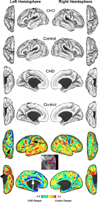Cortical folding is altered before surgery in infants with congenital heart disease
- PMID: 23988135
- PMCID: PMC3905308
- DOI: 10.1016/j.jpeds.2013.06.045
Cortical folding is altered before surgery in infants with congenital heart disease
Abstract
Infants with congenital heart disease have altered brain development. We characterized cortical folding, a critical part of brain development, in congenital heart disease infants and demonstrated an overall decrease in cortical surface area and cortical folding with regional alterations in the right lateral sulcus and left orbitofrontal region, cingulate region, and central sulcus. These abnormalities were present prior to surgery.
Keywords: CHD; CSA; Congenital heart disease; Cortical surface area; GI; Gyrification index; MRI; Magnetic resonance imaging.
Copyright © 2013 Mosby, Inc. All rights reserved.
Conflict of interest statement
The authors declare no conflicts of interest.
Figures


References
-
- Miller SP, McQuillen PS, Hamrick S, Xu D, Glidden DV, Charlton N, et al. Abnormal brain development in newborns with congenital heart disease. N Engl J Med. 2007;357:1928–1938. - PubMed
-
- Clouchoux C, du Plessis AJ, Bouyssi-Kobar M, Tworetzky W, McElhinney DB, Brown DW, et al. Delayed Cortical Development in Fetuses with Complex Congenital Heart Disease. Cereb Cortex. 2012 - PubMed
Publication types
MeSH terms
Grants and funding
LinkOut - more resources
Full Text Sources
Other Literature Sources
Medical

